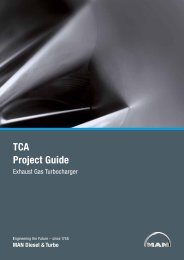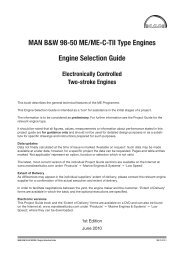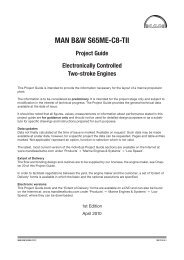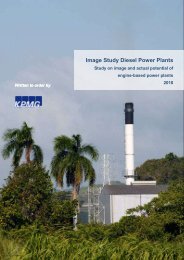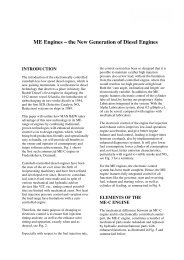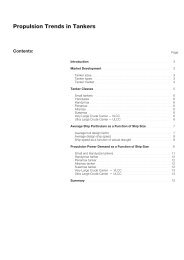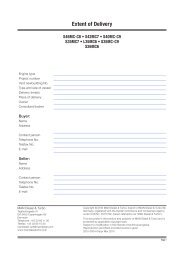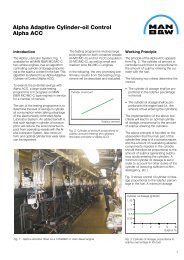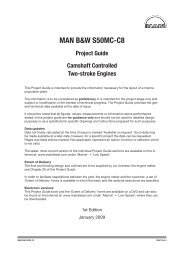Field Experience L27/38 Propulsion Engine ... - MAN Diesel & Turbo
Field Experience L27/38 Propulsion Engine ... - MAN Diesel & Turbo
Field Experience L27/38 Propulsion Engine ... - MAN Diesel & Turbo
You also want an ePaper? Increase the reach of your titles
YUMPU automatically turns print PDFs into web optimized ePapers that Google loves.
<strong>Field</strong> <strong>Experience</strong><br />
<strong>L27</strong>/<strong>38</strong> <strong>Propulsion</strong> <strong>Engine</strong> Powering<br />
M/V MARK AMAY
Contents<br />
<strong>MAN</strong> B&W <strong>Diesel</strong><br />
Introduction .................................................................................................5<br />
M/V MARK AMAY – principal particulars ................................................................6<br />
Vessel in operation .......................................................................................6<br />
Status after two years ..................................................................................7<br />
Local support in Ireland ................................................................................7<br />
<strong>Engine</strong>er on board ........................................................................................8<br />
20,000 hours of operation ............................................................................8<br />
Return from Skagen to the fishing grounds ...................................................9<br />
33,700 hours of operation ...........................................................................9<br />
46,300 hours of operation – class survey and component inspection ......... 10<br />
Cylinder liners ............................................................................................ 10<br />
Cylinder heads ........................................................................................... 11<br />
Pistons and connecting rods ...................................................................... 12<br />
Main and connecting rod bearings .............................................................. 12<br />
Fuel injection pumps .................................................................................. 13<br />
Other inspections ....................................................................................... 14<br />
Future maintenance intervals ...................................................................... 14<br />
Time between overhaul .............................................................................. 14<br />
Continuous development and future perspective ........................................ 15<br />
Appendix: Lube oil analysis ........................................................................ 17<br />
<strong>Field</strong> <strong>Experience</strong> <strong>L27</strong>/<strong>38</strong> <strong>Propulsion</strong> <strong>Engine</strong> Powering M/V MARK AMAY<br />
3
<strong>Field</strong> <strong>Experience</strong><br />
<strong>L27</strong>/<strong>38</strong> <strong>Propulsion</strong> <strong>Engine</strong> Powering M/V MARK AMAY<br />
The following paper describes our field<br />
experience with <strong>MAN</strong> <strong>Diesel</strong> four-stroke<br />
propulsion engine type, <strong>L27</strong>/<strong>38</strong>, power-<br />
ing the Irish fishing vessel M/V MARK<br />
AMAY, built at Karstensens Shipyard in<br />
Skagen, Denmark.<br />
Introduction<br />
Since the introduction of the <strong>L27</strong>/<strong>38</strong> se-<br />
ries during the year 1999-2000 a large<br />
number of engines have been ordered<br />
and delivered from the Danish produc-<br />
tion plants and <strong>MAN</strong> <strong>Diesel</strong> licensees.<br />
The <strong>L27</strong>/<strong>38</strong> engine series has reached<br />
a high level of success within more mar-<br />
ket segments, such as marine propul-<br />
sion plants, marine generating sets and<br />
stationary power plants. Today, a total<br />
of 2,180 engines are ordered/in op-<br />
eration on different fuels, ranging from<br />
marine gas oil (MGO), marine diesel oil<br />
(MDO), heavy fuel oils (HFO) – to vari-<br />
<strong>L27</strong>/<strong>38</strong> – basic engine and performance data<br />
Bore mm 270<br />
Stroke mm <strong>38</strong>0<br />
Stroke/bore ratio 1.41:1<br />
Swept volume/cyl ltr 21.8<br />
Cyl nos in line 6-7-8-9<br />
Speed rev/min 800<br />
Mean piston speed m/s 10.1<br />
Max press bar 195<br />
SLOC g/kWh 0.5-0.8<br />
Power range kW 2,040-3,060<br />
SFOC (mcr) * g/kWh 182<br />
Bmep bar 23.5<br />
Output/cyl kW 340<br />
Fuel MGO/MDO/HFO<br />
Fig. 1: M/V MARK AMAY after arrival at its homeport at Killybegs, Ireland<br />
ous biofuels in stationary power plants.<br />
Out of that, 370 propulsion engines (a<br />
large part operating on HFO) and more<br />
than 1,800 generator engines (majority<br />
operating on HFO) have been delivered<br />
or are in our order backlog.<br />
*) without engine driven pumps at ISO condition, with 5% tolerance and heat release of 42,700 kJ/kg<br />
<strong>MAN</strong> B&W <strong>Diesel</strong><br />
This paper will deal with the experience<br />
gained from the <strong>L27</strong>/<strong>38</strong> propulsion en-<br />
gines, which can be delivered as in-line<br />
engines with 6, 7, 8 and 9 cylinders,<br />
covering the power range from 2,040-<br />
3,060 kW. Since 2006, this engine type<br />
has been delivered with an output up to<br />
3,285 kW.<br />
<strong>Field</strong> <strong>Experience</strong> <strong>L27</strong>/<strong>38</strong> <strong>Propulsion</strong> <strong>Engine</strong> Powering M/V MARK AMAY<br />
5
M/V MARK AMAY – principal particulars<br />
The stern trawler was delivered from<br />
the building yard in Skagen in Decem-<br />
ber 2000.<br />
Vessel name MARK AMAY<br />
IMO Number 921721<br />
Shipyard Karstensens<br />
Yard number <strong>38</strong>2<br />
Skibsværft A/S<br />
Type Twin rig trawler<br />
Tonnage 60 GT<br />
Length o.a. <strong>38</strong>.3 m<br />
Length p.p 32.8 m<br />
Breadth (mld) 10.5 m<br />
Depth (mld) 6.85 m<br />
Draught 6.2 m<br />
Class DNV<br />
Notation +1A1, Fishing Vessel,<br />
Ice C<br />
The M/V MARK AMAY is powered by<br />
a 6-cylinder <strong>MAN</strong> <strong>Diesel</strong> main engine,<br />
type <strong>L27</strong>/<strong>38</strong>, operated on MGO.<br />
The complete <strong>MAN</strong> <strong>Diesel</strong> propulsion<br />
package consists of:<br />
<strong>MAN</strong> <strong>Diesel</strong> engine, type 6<strong>L27</strong>/<strong>38</strong>,<br />
rated 2,040 kW at 800 r/min.<br />
<strong>MAN</strong> <strong>Diesel</strong> gearbox, AMG28 type<br />
52VO27, with a PTO for a 1,200 kW<br />
Stamford shaft alternator<br />
<strong>MAN</strong> <strong>Diesel</strong> CP Propeller, type VB860<br />
– 3,400 mm diameter propeller<br />
<strong>MAN</strong> <strong>Diesel</strong> Alphatronic control sys-<br />
tem, type AT2000<br />
Fig. 4 and 5: M/V MARK AMAY on its way to the fishing banks in the Atlantic Ocean<br />
6 <strong>Field</strong> <strong>Experience</strong> <strong>L27</strong>/<strong>38</strong> <strong>Propulsion</strong> <strong>Engine</strong> Powering M/V MARK AMAY<br />
Fig. 3: <strong>MAN</strong> <strong>Diesel</strong> <strong>L27</strong>/<strong>38</strong> – the complete propulsion solution<br />
Vessel in operation<br />
In June 2007, the M/V MARK AMAY<br />
had accumulated the most running<br />
hours for the engine type (totally 46,300<br />
hrs) and we took the opportunity to in-<br />
spect the engine components in detail<br />
due to a parts investigation for TBO<br />
(Time Between Overhaul) and a lifetime<br />
expectancy analysis, and also to give<br />
an objective technical judgement of the<br />
engine reliability, strengths and robust-<br />
ness.
Until June 2006, the vessel had been<br />
fishing in the Atlantic Ocean on the west<br />
side of Killybegs, which is the home<br />
port of the trawler, located in the North-<br />
western part of Ireland. In June 2007,<br />
the trawler was sold to a new owner<br />
from the Faroe Islands and the future<br />
working place will be coastal fishing<br />
banks. However, the prior shipowner,<br />
Mr Shaun Conneely and his chief en-<br />
gineer Mr Féilem O´Muiri (since 2002)<br />
have been very helpful providing us with<br />
all the necessary information including<br />
the daily observations and records from<br />
the engine log books.<br />
The engine usually runs with a shaft al-<br />
ternator supplying power to the trawler<br />
and main switchboard and powering<br />
the hydraulic pumps and stern thrust-<br />
ers during fishing. The average engine<br />
load varies between 70-80% during<br />
fishing and full load during steaming to<br />
and from the fishing place.<br />
This paper will not deal with how fish-<br />
ing has performed, as this is beyond<br />
our knowledge, but based on informa-<br />
tion from crew members the fishing<br />
performance has been excellent and<br />
expectations have been fulfilled 100%.<br />
The voyages of the M/V MARK AMAY<br />
have been performed without any inter-<br />
ruptions and the entire propulsion plant<br />
from <strong>MAN</strong> <strong>Diesel</strong> has not caused any<br />
off-hire days.<br />
<strong>MAN</strong> B&W <strong>Diesel</strong><br />
Status after two years<br />
<strong>Experience</strong>s accumulated from the first<br />
12,000 running hours – corresponding<br />
to the first two years of the operation<br />
period:<br />
After approx. 1,000 hrs of operation,<br />
the lube oil consumption is reported<br />
to 1.05 g/kWh, which is 50-60%<br />
higher than expected. The bore-<br />
scope inspection did not show any<br />
abnormalities and honing marks were<br />
100% visible. To avoid any off-hire, it<br />
was decided to postpone withdrawal<br />
of pistons until the end of the year as<br />
fishing and fishing prices were very<br />
satisfactory at the time being.<br />
After 2,100 hrs, a HT water pump fail-<br />
ure occurred due to inadequate de-<br />
sign of the shaft for tightening the im-<br />
peller. A preliminary repair took place<br />
in May 2001. Consequently, both HT<br />
and LT pumps were replaced by an<br />
improved version a few months after<br />
to avoid further trouble.<br />
The <strong>Engine</strong> Operator Panel on the<br />
engine failed due to lack of vibration<br />
dampers. A new panel with vibration<br />
dampers was fitted.<br />
In October 2001, after 5,900 hrs<br />
of operation, the vessel planned to<br />
go back to Skagen for a guaran-<br />
tee docking, and it was decided to<br />
withdraw all 6 pistons for investiga-<br />
tions concerning the excessive lube<br />
oil consumption. Cylinder liners were<br />
cleaned and slightly honed and a<br />
modified ring package was fitted on<br />
all 6 pistons.<br />
A turbocharger breakdown at sea tri-<br />
al on 17 October 2001. A broken flap<br />
valve from the by-pass valve entered<br />
the turbine due to a design failure on<br />
the by-pass valve system. The vessel<br />
returned to Skagen with reduced en-<br />
gine load. The turbocharger unit was<br />
exchanged and the by-pass valve<br />
system was modified, and the failure<br />
risk thus totally eliminated. All sup-<br />
plied free of charge.<br />
A combined relay and control valve<br />
for the starter motor failed twice and<br />
a new improved version was deliv-<br />
ered in December 2001. The en-<br />
gine could be emergency started.<br />
The air starter turbine was worn out<br />
due to inadequate air filtration. A re-<br />
conditioned air starter and a new<br />
modified air filter was sent to the ship<br />
(as a gesture of goodwill compensa-<br />
tion) in December 2002, after more<br />
than12,000 hrs of operation.<br />
The above-mentioned repair work<br />
mainly took place in Killybegs during the<br />
unloading of fish or at the planned yard<br />
stay in Skagen in October 2001.<br />
Local support in Ireland<br />
Because of the increasing domestic<br />
fishing activities and the need for quick<br />
support in the western parts of Ireland,<br />
we introduced the company Showlin<br />
Marine Ltd, Killybegs, which today is an<br />
Authorised Repair Shop for <strong>MAN</strong> <strong>Diesel</strong>.<br />
<strong>Field</strong> <strong>Experience</strong> <strong>L27</strong>/<strong>38</strong> <strong>Propulsion</strong> <strong>Engine</strong> Powering M/V MARK AMAY<br />
7
Figs. 6: and 7 M/V MARK AMAY engine room – very clean and well maintained<br />
<strong>Engine</strong>er on board<br />
Also worth mentioning is that a new<br />
well-experienced chief engineer Mr<br />
Féilem O´Muiri started working on the<br />
vessel in the very beginning of 2002. He<br />
had a good understanding of operating<br />
the plant and kept both engine and the<br />
surrounding equipment in a very good<br />
and clean condition.<br />
The only concern for the shipowners<br />
and chief engineer was the lube oil con-<br />
sumption reported at the end of No-<br />
vember 2002, close to 0.9 g/kWh and<br />
approx. 25% higher than what <strong>MAN</strong><br />
<strong>Diesel</strong> had specified as maximum. The<br />
engine had operated a total of 17,000<br />
hrs (11,000 hrs after change of piston<br />
rings). Since the lube oil consumption<br />
did not elevate dramatically, the ship-<br />
owner decided to postpone the repair<br />
and the engine check until the summer<br />
period 2003 when the engine had ac-<br />
cumulated 20,000 running hours.<br />
Seen in the engineer’s Log Book for the<br />
period 27 December 2002 to 19 August<br />
2003, the following work had been car-<br />
ried out by the crew:<br />
14-01-2003: New coupling fitted to<br />
engine-driven sea water<br />
pump<br />
22-02-2003: Modified IR relay valve<br />
fitted on the air starter<br />
(supplied free of charge<br />
as a gesture of goodwill)<br />
03-03-2003: Fuel injection pipes fitted<br />
on cylinder nos. 3 and 5<br />
20,000 hours of operation<br />
Subsequently, the owner planned to<br />
overhaul the engine since it had reached<br />
20,000 hrs of operation. On 19 August<br />
2003, the vessel arrived at Skagen and<br />
the following parts were requested to<br />
be repaired/maintained:<br />
1. Cylinder heads<br />
The cylinder heads were overhauled<br />
at our Service Center workshop in<br />
Frederikshavn. Exhaust and inlet<br />
valves, seat rings, rotor caps, valve<br />
guides, and safety valves were con-<br />
trolled for wear. Four inlet valves<br />
and the corresponding seat rings<br />
were renewed due to some wear on<br />
the inlet valves<br />
8 <strong>Field</strong> <strong>Experience</strong> <strong>L27</strong>/<strong>38</strong> <strong>Propulsion</strong> <strong>Engine</strong> Powering M/V MARK AMAY<br />
2. Fuel valves<br />
The fuel injection valves were over-<br />
hauled in Frederikshavn<br />
3. Cylinder liners<br />
All liners were replaced due to de-<br />
sign changes. Liners were not worn<br />
out at all and the wear rate was not<br />
measurable<br />
4. Pistons and piston rings<br />
The pistons were modified and up-<br />
dated to the newest design stage<br />
and the piston rings were also re-<br />
newed to the last development<br />
stage. Related costs for the piston<br />
modifications were covered by <strong>MAN</strong><br />
<strong>Diesel</strong><br />
Liners, pistons and piston rings were<br />
modified/renewed at the request of<br />
<strong>MAN</strong> <strong>Diesel</strong>, as an updating to the<br />
recent design was also in the inter-<br />
est of the company<br />
5. Connecting rod bearings<br />
In order to carry out laboratory in-<br />
vestigations, four connecting rod<br />
bearings were replaced. The bear-
ings could have continued the op-<br />
eration without concern<br />
6. Main bearings<br />
Main bearing nos. 3 and 5 were re-<br />
newed and the old bearings were<br />
forwarded to the <strong>MAN</strong> <strong>Diesel</strong> Augs-<br />
burg laboratory for investigation.<br />
The remaining five main bearing<br />
sets continued operation. The ex-<br />
tended investigation carried out in<br />
our laboratories later showed, that<br />
the bearing set nos. 3 and 5 could<br />
have continued operation, and that<br />
the selected bearing material was fit<br />
for purpose<br />
7. Camshafts<br />
The camshaft sections were inspec-<br />
ted and found in perfect condition<br />
8. <strong>Turbo</strong>charger<br />
The turbocharger was overhauled<br />
at our Service Center workshop<br />
in Frederikshavn. The rotating ele-<br />
ments were controlled for correct<br />
balance and nothing was to be<br />
remarked. Only soft parts were re-<br />
quired<br />
9. Cooling water pumps<br />
LT and HT water pumps were con-<br />
trolled and found in good condition<br />
10. Vibration damper<br />
The vibration damper on the crank-<br />
shaft was controlled and found in<br />
good condition<br />
11. Lube oil filter<br />
The lube oil automatic back-flushing<br />
filter was controlled and assembled<br />
with new sealing rings<br />
<strong>MAN</strong> B&W <strong>Diesel</strong><br />
Return from Skagen to the fishing<br />
grounds<br />
In September 2003, M/V MARK AMAY<br />
left Skagen and returned to Ireland for<br />
the fishing season. The fishing contin-<br />
ued until August 2005 after 33,700 hrs<br />
of operation when the ship returned to<br />
Karstensens Shipyard in Skagen. The<br />
main engine had operated well and<br />
required only normal maintenance ac-<br />
cording to the standard programme.<br />
The engine did not consume any spare<br />
parts and only the below three topics/<br />
events from the chief engineer’s log<br />
books are worth mentioning:<br />
Work carried out by the crew<br />
February - 2004:<br />
Replacement of fuel injection pump<br />
no. 6, which seizures after a tremen-<br />
dous amount of water in the service<br />
tank. Afterwards, the crew flushed<br />
the entire fuel system and replaced<br />
all fuel injection filters on main engine<br />
and aux. engines as well<br />
April - 2005:<br />
Replacement of fuel injection pump<br />
no 2. with the spare unit, due to leak-<br />
Fig. 8: M/V MARK AMAY at Karstensens slipway<br />
ages on top cover area<br />
May - 2005:<br />
Exhaust sensor no. 2 renewed<br />
33,700 hours of operation<br />
<strong>MAN</strong> <strong>Diesel</strong> service engineers attended<br />
the vessel in Skagen, August 2005,<br />
and carried out the following work after<br />
33,700 hrs of operation:<br />
All fuel injectors removed to work-<br />
shop and reconditioned<br />
Bore scope inspection of all cylinder<br />
units. All were found in good condi-<br />
tion<br />
Lube oil consumption recorded to<br />
approx. 0.5-0.6 g/kWh, which is very<br />
good<br />
Main bearing screws and the screws<br />
for the counterweights were retight-<br />
ened<br />
Worked on temporary “Tacho error<br />
failure”, but did not trace the failure.<br />
The turbocharger was overhauled<br />
Fuel injection pumps nos. 1, 3 and<br />
5 were exchanged to reconditioned<br />
pumps by the ship’s crew.<br />
<strong>Field</strong> <strong>Experience</strong> <strong>L27</strong>/<strong>38</strong> <strong>Propulsion</strong> <strong>Engine</strong> Powering M/V MARK AMAY<br />
9
After the very limited repair and main-<br />
tenance work, the engine operated<br />
trouble-free and only daily maintenance<br />
work took place until the ship arrived<br />
at Karstensens Shipyard in June 2007<br />
for a major overhaul – a new shipowner<br />
from Faroe Islands subsequently took<br />
over the responsibility of the ship and<br />
propulsion plant. The lube oil consump-<br />
tion (after 26,300 hrs of operation after<br />
the last overhaul) was still relatively low,<br />
but slightly elevated during the last 6<br />
months’ operation up to the range of<br />
0.8 - 0.85 g/kWh. The lube oil analysis<br />
reports (see appendix) confirm that the<br />
oil is in a stable and good condition.<br />
46,300 hours of operation – class survey<br />
and component inspection<br />
The engine was repaired/overhauled<br />
during the summer 2007, and we fol-<br />
lowed up on the main components after<br />
a total of 46,300 hrs of operation.<br />
Cylinder liners<br />
Cylinder liners were withdrawn and<br />
returned to the Service Center repair<br />
shop in Frederikshavn with the purpose<br />
of measuring the liner wear and also re-<br />
honing the liners.<br />
The liners looked fine after 26,300 hrs<br />
of operation and the honing marks were<br />
visible on the entire liner surface.<br />
The liner diameter was measured be-<br />
fore and after the honing. The diameter<br />
was still within the tolerance limits of the<br />
design drawing. 270H7 ≈ Minimum di-<br />
ameter 270.00 and Maximum diameter<br />
270.052. After honing, the diameter<br />
reached 270.07 mm, which indicates<br />
that the liners have sufficient material for<br />
at least another two honing recondition-<br />
ings, since we can re-hone the diameter<br />
up to 270.20 mm.<br />
10 <strong>Field</strong> <strong>Experience</strong> <strong>L27</strong>/<strong>38</strong> <strong>Propulsion</strong> <strong>Engine</strong> Powering M/V MARK AMAY<br />
Fig. 9: Liner no. 4 in the upper TDC point after 26,300 hrs of operation<br />
Fig. 10: Liner no. 3 exhaust side in the upper TDC point after 26,300 hrs of operation<br />
Calculating the wear rate of the liners,<br />
we normally used the key figures by<br />
calculating the wear rate in [µm/1,000<br />
hrs operation] and in this case we ob-
Fig. 11: Cylinder head inlet – and exhaust ring. Coke deposit limited after<br />
26,300 hrs of operation<br />
Fig. 13: Exhaust valve after 46,300 hrs of operation<br />
tained an exceptionally low wear rate of<br />
2 [µm/1,000 hrs].<br />
On MGO operation, the liners can reach<br />
a total lifetime of 80,000 hrs, which<br />
meet our expectations.<br />
With the low wear rate and the con-<br />
sequently good TBO of the liners, we<br />
expect that the liners can be recondi-<br />
tioned 3 times in total, before the upper<br />
wear limit of 270.4 mm is exceeded,<br />
and the liners can meet our 80,000 hrs<br />
lifetime expectation.<br />
<strong>MAN</strong> B&W <strong>Diesel</strong><br />
Cylinder heads<br />
All cylinder heads were dismantled for<br />
cleaning and repair. Components such<br />
as valves, valve seat rings, valve rota-<br />
tors, valve bridges rocker arm shaft and<br />
bearing bushes were overall in excellent<br />
condition after a total of 46,300 hrs.<br />
However, at the end of the repair, we<br />
have only renewed 2 inlet valves and 12<br />
exhaust valve seat rings. The exhaust<br />
valve seat rings were replaced because<br />
of minor water leakages around the 2<br />
seat rings, due to an improper water in-<br />
hibitor added to the HT water.<br />
Fig. 12: Exhaust seat ring – corrosion-damaged due to inadequate cooling<br />
water inhibitor<br />
Fig. 14: Exhaust rocker arm bush after 46,300 hrs of operation. Can con-<br />
tinue operation<br />
All 24 valve rotators (used on both in-<br />
let – and outlet valves) could continue<br />
service despite our best expectations<br />
for a lifetime of 48,000 running hrs,<br />
which can be met easily.<br />
Also the pressure safety valves were<br />
checked for possible maintenance,<br />
which had to be carried out as a matter<br />
of routine. However, nothing abnormal<br />
was found.<br />
<strong>Field</strong> <strong>Experience</strong> <strong>L27</strong>/<strong>38</strong> <strong>Propulsion</strong> <strong>Engine</strong> Powering M/V MARK AMAY<br />
11
Pistons and connecting rods<br />
The two-part pistons were all disman-<br />
tled for cleaning and overhaul. The pis-<br />
ton skirt (lower part) looked nice and<br />
completely free from glanced areas in<br />
the running layer (Molycote threaded)<br />
and the lower part of the piston contin-<br />
ued operation without any repair.<br />
Owing to <strong>MAN</strong> <strong>Diesel</strong>’s continuous de-<br />
velopment philosophy, the piston top<br />
and the piston ring design have been<br />
modified, since the Mark Amay engine<br />
was built. We decided to replace all<br />
piston tops, despite of the fact that the<br />
wear rate of piston ring grooves could<br />
have continued operation. The ben-<br />
efit regarding better “long time” lube<br />
oil control and less deposits in the ring<br />
grooves justified our decision of replac-<br />
ing the piston tops.<br />
The new piston top rings fitted were<br />
chromium-plated on both flanks in or-<br />
der to minimise the ring groove wear<br />
rate, when operating on HFO (Heavy<br />
Fuel Oil). Since the introduction of this<br />
top ring in 2005, our HFO service ex-<br />
perience has shown a 50% reduction<br />
of the ring groove wear rate. With this<br />
upgrading of the engine, a piston top<br />
lifetime of 80,000 running hours could<br />
easily be fulfilled before exceeding the<br />
scrapping criterion of 6.42 mm.<br />
Main and connecting rod bearings<br />
During our inspection after 20,000 run-<br />
ning hours, main bearing nos. 3 and 5<br />
were taken out and forwarded for in-<br />
vestigation in our Augsburg laboratory<br />
and later by the bearing supplier. The<br />
remaining five main bearings continued<br />
operation until now, having accumu-<br />
lated a total of 46,300 hrs of operation.<br />
Fig. 15: Piston top crown in good condition after<br />
26,300 hrs of operation since the last withdrawal<br />
Fig. 17: Main bearing no. 1 after 46,300 hrs of<br />
operation<br />
12 <strong>Field</strong> <strong>Experience</strong> <strong>L27</strong>/<strong>38</strong> <strong>Propulsion</strong> <strong>Engine</strong> Powering M/V MARK AMAY<br />
Fig. 19: Main bearing no. 1 after a blow-up (30<br />
times) Miba “Rillenlager” structure in good condi-<br />
tion<br />
Fig. 16: Piston skirt can continue service after re-<br />
conditioning of the piston steel top<br />
Fig. 18: Close-up photo of main bearing no. 1<br />
Fig. 20: Main bearing no. 1 - Back side of lower<br />
main bearing shell<br />
Detail for temperature sensor<br />
- No fretting
The connecting rod bearings had all ac-<br />
cumulated 26,300 running hours. All six<br />
bearing sets are in good condition, and<br />
it was decided to continue operation<br />
with the connecting rod bearing sets.<br />
However, we emphasised to the new<br />
owner of the ship and his engine staff<br />
that we strongly require that the maxi-<br />
mum safe running period for the large<br />
end bearings is to be limited to 36,000<br />
hrs of operation, which meet our expec-<br />
tations to lifetime.<br />
Fuel injection pumps<br />
The fuel injection pumps were over-<br />
hauled by the crew, and the lifetime<br />
of plungers and barrels seemed to be<br />
limited to 30,000-40,000 running hours<br />
on MGO. The pump from cylinder no.<br />
4 had the longest operating period of<br />
37,934 hrs, and we took the opportu-<br />
nity to inspect the plunger and barrel.<br />
Inspection of fuel injection pump no 4:<br />
Minor cavitation marks on the plunger<br />
top<br />
Scratch mark in lengthwise direction<br />
on the lower part of the piston<br />
Severe cavitations at the inlet holes at<br />
low pressure side<br />
The above pump element was ready to<br />
be renewed and it looked like the TBO<br />
for the pump was reached after 36,000<br />
running hrs at MGO, which more than<br />
fulfil our guidelines for lifetime.<br />
<strong>MAN</strong> B&W <strong>Diesel</strong><br />
Fig. 21: Main bearing no. 2 - Cavitations mark<br />
visible<br />
Fig. 22: Main bearing no. 2 – Close-up of the cavi-<br />
tation marks. Visible at the ends of the oil grooves<br />
Fig. 23: Plunger with cavitation Fig. 24: Cavitation marks at the inlet bore low<br />
Fig. 25: Detail with inlet bore<br />
pressure side<br />
<strong>Field</strong> <strong>Experience</strong> <strong>L27</strong>/<strong>38</strong> <strong>Propulsion</strong> <strong>Engine</strong> Powering M/V MARK AMAY<br />
13
Fig. 26 Fuel cam no. 6 Fig. 27 Valve cams and roller guides for cyl. no. 6<br />
Other inspections<br />
All other inspections during the gener-<br />
al overhaul did not reveal any adverse<br />
conditions. Special attention was paid<br />
to cams, rollers, crankshaft journals<br />
and the <strong>MAN</strong> <strong>Diesel</strong> turbocharger type<br />
NR24/S. The cams and rollers had al-<br />
most the same appearance, as when<br />
the engine left the testbed. A crank-<br />
shaft check for possible journal wear<br />
was carried out and the journals were<br />
found to be in excellent condition. The<br />
vibration damper (sleeve spring damper<br />
type) on the front end of the crankshaft<br />
was checked, and nothing irregular was<br />
found.<br />
Future maintenance intervals<br />
When the <strong>L27</strong>/<strong>38</strong> engine was intro-<br />
duced, our target was a TBO of 24,000<br />
for a MGO plant for a general overhaul.<br />
It has now been proved - after the<br />
modifications made to the ring pack and<br />
cylinder liners during the first overhaul in<br />
August 2003 – that the target has been<br />
reached. For pistons, modified piston<br />
rings, liners and bearings, we are con-<br />
vinced that a TBO of 30,000 hrs can be<br />
reached on this particular plant.<br />
However, it should also be empha-<br />
sised that the qualified crew on the<br />
M/V MARK AMAY has followed our<br />
planned maintenance programme and<br />
carried out maintenance of the engine<br />
regularly, according to the Instruction<br />
Manual.<br />
14 <strong>Field</strong> <strong>Experience</strong> <strong>L27</strong>/<strong>38</strong> <strong>Propulsion</strong> <strong>Engine</strong> Powering M/V MARK AMAY<br />
Time between overhaul<br />
After these modifications, the following<br />
TBO times can be achieved for MGO<br />
operation:<br />
Cylinder liners 30,000 hrs<br />
Piston rings 30,000 hrs<br />
Piston crowns 80,000 hrs<br />
Cylinder covers 30,000 hrs<br />
*Main bearings 48,000 hrs<br />
*Connecting rod bearings 36,000 hrs<br />
Vibration damper 60,000 hrs<br />
Fuel pumps 36,000 hrs<br />
<strong>Turbo</strong>charger 24,000 hrs<br />
Injectors 6,000 hrs<br />
* Based on component inspection of 1 or 2 units<br />
at 24,000 hrs<br />
The above TBOs are then coinciding<br />
with the intermediate survey and con-<br />
trol of the machinery.
Continuous development and future<br />
perspective<br />
The award-winning <strong>MAN</strong> <strong>Diesel</strong> L21/31<br />
and <strong>L27</strong>/<strong>38</strong> design generation has<br />
clearly set the new standard for mod-<br />
ern medium-speed propulsion die sels.<br />
A very visible step forward. Right from<br />
the very first glance at the clean-lined<br />
exterior – to the closer look at the inter-<br />
nal details.<br />
The modular design of the engines –<br />
with front-end and aft-end boxes car-<br />
rying all auxiliary equipment for lube<br />
oil and cooling water circuits – gives<br />
them an uncluttered appearance. Fur-<br />
thermore, this also leads to practical as<br />
well as aesthetic benefits, permitting<br />
e.g. removal of each cylinder assembly<br />
(cylinder head, piston, connecting rod<br />
and liner) as a complete individual unit.<br />
This vastly reduces the time required for<br />
Fig. 28: <strong>L27</strong>/<strong>38</strong> complete cylinder unit<br />
maintenance or replacement. Addition-<br />
ally, this well conceived design has only<br />
a minimal overhead height requirement.<br />
However, the necessary lifting height<br />
above the cylinder heads can not al-<br />
ways be met on smaller fishing vessels.<br />
Therefore, the design also gives the<br />
Fig. 29: <strong>L27</strong>/<strong>38</strong> propulsion engine – a service and maintenance-friendly modularised unit concept<br />
<strong>MAN</strong> B&W <strong>Diesel</strong><br />
freedom to separate the components in<br />
the traditional way by withdrawing first<br />
the cylinder heads, piston and connect-<br />
ing rods, and last the cylinder liners.<br />
With the company goal to maintain and<br />
improve engine performance, reliability<br />
and the market position, the engines<br />
undergo <strong>MAN</strong> <strong>Diesel</strong>’s continues de-<br />
velopment philosophy. For instance,<br />
engine type <strong>L27</strong>/<strong>38</strong> has been modified/<br />
improved with regard to a number of<br />
components - first of all with the pur-<br />
pose of making the engine even more<br />
attractive, economic, reliable and clean.<br />
Nowadays, there is strict legislation on<br />
engine designs to meet the environ-<br />
mental requirements of tomorrow. This<br />
results in ongoing R&D activities to re-<br />
duce emissions and particles, without<br />
conflicting with the overall requirements,<br />
and simultaneously to have moderate<br />
investment costs and low operational<br />
costs via low specific fuel oil consump-<br />
tion over the entire load range.<br />
Furthermore, new costumer-related in-<br />
quiries have resulted in new develop-<br />
ments of the engine and its applica-<br />
tions.<br />
<strong>Field</strong> <strong>Experience</strong> <strong>L27</strong>/<strong>38</strong> <strong>Propulsion</strong> <strong>Engine</strong> Powering M/V MARK AMAY<br />
15
In the following summary, the most im-<br />
portant design modifications, features<br />
and benefits for the <strong>L27</strong>/<strong>38</strong> propulsion<br />
engine have been listed:<br />
A. Improvement/modification of piston<br />
and piston ring pack for improvement<br />
of the TBO<br />
B. Modification of cooling water jacket<br />
for equal temperature in the liner top<br />
circumference<br />
C. Modification of cylinder liners to “free<br />
hanging” version for improving the<br />
TBO for cylinder units<br />
D. Improvement of fuel injection pumps<br />
in order to minimise the risk of cavita-<br />
tions / erosion in the pipe system.<br />
E. Design of engine control system for<br />
operation with Munters SCR convert-<br />
ers, which can reduce the NOX emis-<br />
sions to a level below 2 g/kWh.<br />
F. Uprating of the engine by strength-<br />
ening / improving some components<br />
enabling us to increase BMEP to<br />
25.2 bar. <strong>Engine</strong> load elevated from<br />
340 kW/cyl. to 365 kW/cyl. in order<br />
to reach a new customer demand<br />
G. Introduction of the new <strong>MAN</strong> <strong>Diesel</strong><br />
turbocharger generation type TCR.<br />
The main purpose was to ensure<br />
faster engine response during ma-<br />
noeuvring and additionally to improve<br />
the turbocharger and overall plant ef-<br />
ficiency and reduction of the NOX<br />
H. Introduction of new fuel injection at-<br />
omisers “low sack” version for opti-<br />
mising combustion behaviour and re-<br />
ducing soot and particle emission in<br />
order to come closer to the restrictive<br />
EPA Tier2 legislation<br />
I. New low “dry sump” oil pan (as cus-<br />
tomer option) suitable for plants with<br />
separate oil tank<br />
J. Special insulation of hot surfaces (as<br />
customer option) to meet the de-<br />
mand to ensure all surface tempera-<br />
tures be kept below 100°C<br />
Within its power range, the <strong>L27</strong>/<strong>38</strong> is<br />
the most attractive and safe engine in-<br />
vestment today. An engine design with<br />
high safety margins offering lots of po-<br />
tential for the future.<br />
16 <strong>Field</strong> <strong>Experience</strong> <strong>L27</strong>/<strong>38</strong> <strong>Propulsion</strong> <strong>Engine</strong> Powering M/V MARK AMAY
Appendix: Lube oil analysis<br />
<strong>MAN</strong> B&W <strong>Diesel</strong><br />
<strong>Field</strong> <strong>Experience</strong> <strong>L27</strong>/<strong>38</strong> <strong>Propulsion</strong> <strong>Engine</strong> Powering M/V MARK AMAY<br />
17
18 <strong>Field</strong> <strong>Experience</strong> <strong>L27</strong>/<strong>38</strong> <strong>Propulsion</strong> <strong>Engine</strong> Powering M/V MARK AMAY
<strong>MAN</strong> <strong>Diesel</strong> & <strong>Turbo</strong><br />
Niels Juels Vej 15<br />
DK-9900 Frederikhavn, Denmark<br />
Phone +45 96 20 41 00<br />
Fax +45 96 20 40 30<br />
info-frh@mandieselturbo.com<br />
www.mandieselturbo.com<br />
All data provided in this document is non-binding. This data serves informational purposes only and is especially not guaranteed in any way.<br />
Depending on the subsequent specific individual projects, the relevant data may be subject to changes and will be assessed and determined<br />
individually for each project. This will depend on the particular characteristics of each individual project, especially specific site and operational<br />
conditions · Copyright © <strong>MAN</strong> <strong>Diesel</strong> & <strong>Turbo</strong> · Subject to modification in the interest of technical progress. ·<br />
5510-0037-01ppr Aug 2011 Printed in Denmark



